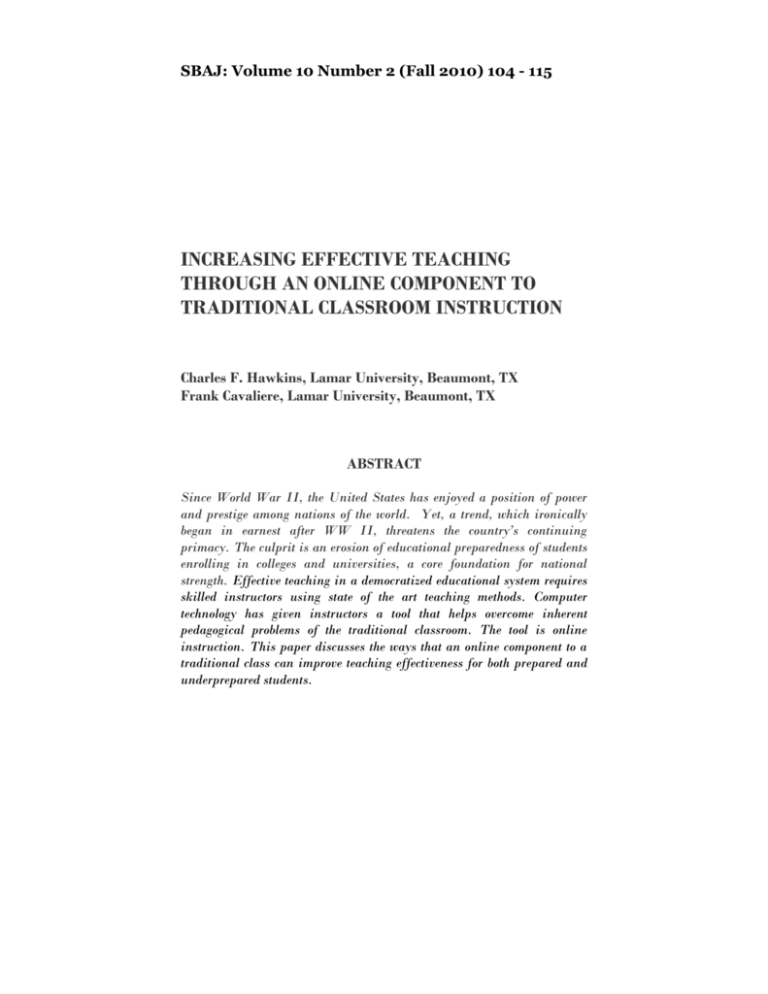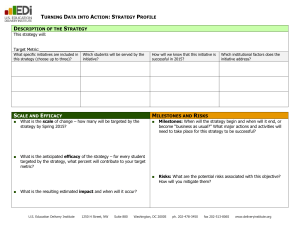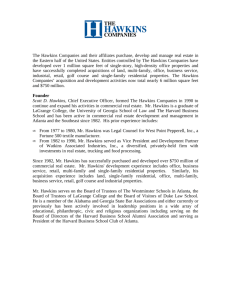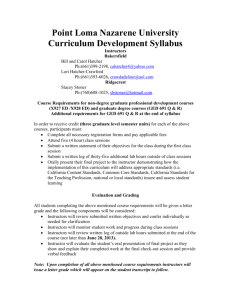increasing effective teaching through an online component to
advertisement

SBAJ: Volume 10 Number 2 (Fall 2010) 104 - 115 INCREASING EFFECTIVE TEACHING THROUGH AN ONLINE COMPONENT TO TRADITIONAL CLASSROOM INSTRUCTION Charles F. Hawkins, Lamar University, Beaumont, TX Frank Cavaliere, Lamar University, Beaumont, TX ABSTRACT Since World War II, the United States has enjoyed a position of power and prestige among nations of the world. Yet, a trend, which ironically began in earnest after WW II, threatens the country’s continuing primacy. The culprit is an erosion of educational preparedness of students enrolling in colleges and universities, a core foundation for national strength. Effective teaching in a democratized educational system requires skilled instructors using state of the art teaching methods. Computer technology has given instructors a tool that helps overcome inherent pedagogical problems of the traditional classroom. The tool is online instruction. This paper discusses the ways that an online component to a traditional class can improve teaching effectiveness for both prepared and underprepared students. Hawkins et al.: Increasing Effective …… 105 INTRODUCTION Since World War II, the United States has enjoyed a position of power and prestige among nations of the world. The country’s political stability, economic vitality, military might, and technological leadership, among other factors, contributed to this prominent position. Yet, a trend, which ironically began in earnest after WW II, threatens the country’s continuing primacy. The culprit is an erosion in educational preparedness of students enrolling in colleges and universities, a core foundation for national strength. In an insightful article, Emily Payne and Barbara Lyman (1996) identified two periods in which large numbers of under prepared students entered the nation’s system of higher education. The first was after WW II when veterans took advantage of educational benefits earned as members of the armed forces. The second was during the 60s, 70s, and 80s when open admission policies and government funding provided opportunities for many who would have otherwise been excluded from post secondary education. In both cases, accessibility to post secondary education was greatly broadened. As reported by Robert H. Fenske and Craig S. Scott (1973): “This country has, since World War II, come to embrace the notion that higher education is not only for an economic or even an intellectually elite, but for all who can profit by it” (1973, 5). As a result of this inclusive trend, student populations became more diverse in age, gender, race, traditions, and in academic ability and training. Accordingly, the democratization of higher education resulted in a general decline in academic preparedness of students enrolled in the country’s colleges and universities. The broadening of access to college education, however, is not nearly as significant a factor in the erosion of academic preparedness as is that of declining achievement by primary and secondary students generally in the United States. Broadening the base of college students simply brought under prepared students into the population mix, which contained well-prepared students as well. However, the decline in achievement by primary and secondary students has reduced the preparedness of the entire population college students. The failure of public primary and secondary education is well recognized. So much so, that despite the fact that state and local governments bear Hawkins et al.: Increasing Effective …… 106 primary responsibility for its delivery, the federal government passed landmark legislation to address the problem. Bipartisan support in both Houses of Congress passed the No Child Left Behind Act, which was signed into law on January 8, 2002. Even with this effort, educational attainment of American students, especially at the high school level continued to deteriorate. In the last year for which international comparisons are available, 2005, data collected by the Organization for Economic Co-operation and Development (OECD) (2008) found that students in the United States lagged behind students of other nations in the areas of reading, math, and science. This occurred despite the fact that the United States tied for first place in expenditures per student. Additionally, information from Inside Higher Ed (2009) indicates that American student performance continued to fall through 2009 in the important areas of critical reading, mathematics, and writing. During the 20052009 period, SAT scores for critical reading fell from 508 to 501, those in mathematics from 520 to 510, and those in writing, which were unavailable in 2005 fell from 497 in 2006 to 493 in 2009. The decline in SAT scores of high school seniors is even more alarming when placed into the context of academic achievement at lower grade levels. Pascal D. Forgione, Jr. (1998) analyzed test results from the Third International Mathematics and Science Study and found that student achievement in the United States falls relative to international cohorts as they move to higher grades. In both mathematics and science, fourth graders scored better than the international average, in the eighth grade domestic students are close to the average, but by the twelfth grade domestic students fall considerably below the average. Furthermore, even the United States’ more advanced students were below the international average for their peer group. If institutions of higher education in general and colleges of business in particular are going to be successful in preparing students to meet the rigors of global competition, it is necessary to explicitly recognize this characteristic of our student population. Something has gone seriously amiss in what has traditionally been expected in the elementary through secondary educational process. Instead of becoming more demanding and requiring more academic discipline, the education system, if comparative test scores are an indication, has Hawkins et al.: Increasing Effective …… 107 done just the opposite. Students are not as well prepared and their study skills are not as strong as was true of students in the past. Diversity exists and must be recognized. Current student populations are not homogeneous with respect to gender, race, country of origin, traditions, or educational preparedness. Just as universities and accreditation bodies recognize and promote the concept of diversity in age, gender, race, country of origin, and traditions, it is necessary to recognize diversity in student preparedness and promote activities to address that issue. There is a rich body of literature dealing with underprepared college students in the United States. Indeed, this subject has attracted so much attention that the National Center for Developmental Education was established at Appalachian State University in Boone, North Carolina. The Center publishes two professional journals, the Journal of Developmental Education (JDE) and Research in Developmental Education (RiDE). While developmental education is widely regarded as being devoted to the needs of the lowest segment of underprepared college students, It is argued in this paper that research on effective teaching methods to reach the lowest group is applicable to all underprepared students (and, perhaps, to prepared students as well). The purpose of this paper is to discuss an education delivery system which includes traditional, face-to-face lecture classes and online components to those classes. It will be demonstrated that such a hybrid system can best satisfy both the requirements for effective teaching and the needs of underprepared students. The guidelines for effective teaching have been adopted from Chickering and Gramson’s (1987) “Seven Principles for Good Practice in Undergraduate Education,” while the guidelines for addressing the needs of underprepared have been adopted from Patricia Smittle’s (2003) “Principles for Effective Teaching.” EFFECTIVE TEACHING The effectiveness of even the most skilled and dedicated teacher is restricted by inherent constraints associated with traditional classrooms. Chief among the constraints are time limitations, Hawkins et al.: Increasing Effective …… 108 difficulty of nurturing individual students in a collective setting, and obstacles to engage students in the learning process. These problems can be mitigated or overcome with online enhancements to traditional classrooms. Encouraging Contact between Students and Faculty: The traditional class. In the traditional classroom setting, attendance policies can be used to encourage consistent contact, at some level, between students and faculty. The contact can be enhanced by required student participation in classroom discussions and question/answer sessions. This, however, may prove to be counterproductive for shy students who are averse to being the focus of attention. Faculty may also require students to meet periodically throughout the semester for small group or individual discussions. Unfortunately, these contacts would be time-consuming for faculty and difficult to schedule with students. With other professional demands on faculty, especially that of scholarly activity, the time constraint is prohibitive. Online enhancement: With an online component to the class, meaningful contact can be made with students. Using the Blackboard delivery system terminology, for example, instructors have several communication tools at their disposal. First, there is the ASSIGNMENT tool. Using this tool permits faculty to ask questions or elicit opinions from all students, who can respond without exposing themselves to others in the class, and to provide timely feedback to students. Additionally, Blackboard also has ANNOUNCEMENT and E-MAIL tools which permit instructors to easily keep in touch with students. Encourage Reciprocity and Cooperation among Students The traditional class: In a traditional setting, an instructor can use a tag-team type question and answer session to build rapport among students. As was identified in the previous discussion, this may be counterproductive for shy students. A greater problem, however, is that of time. To the extent that this technique is used to encourage reciprocity and cooperation among students, it may do so to the Hawkins et al.: Increasing Effective …… 109 detriment of a more effective method for actual subject delivery. Reciprocity and cooperation may also be promoted by assigning students to discussion groups that meet outside of class. Scheduling and transportation problems would have to be overcome and the instructor would have little supervisory control over the group. Online enhancement: The reciprocity and cooperation goal is easily addressed through Blackboard’s CHAT and DISCUSSION tools. The CHAT tool allows real-time interaction among students in class. It can be initiated in response to students’ questions or through a topic developed by the instructor. A limiting feature of this tool is that it requires all students in the class or a designated group of students to be online at the same time, so scheduling problems are a distinct possibility. Because the DISCUSSION tool does not require students to be online at the same time, it is more flexible. For both CHAT and DISCUSSION, student participation can be monitored and evaluated by instructors. Feedback can be provided online or in the classroom setting. These tools also permit shy students to retain a degree of anonymity and they may gain confidence to participate more fully in the traditional class. Encourages Active Learning: Active learning requires students to do more than just physically attend class and robotically complete assignments. Methods of engaging students to assume greater responsibility for their learning are incorporated in the Contact and Reciprocity principles discussed above. Shortcomings of traditional classes and online solutions to those shortcomings are similar and do not need to be repeated here. In fact, all of the principles of effective teaching are interrelated, so satisfying one provides a head start to satisfying others as well. Gives Prompt Feedback: The traditional class: In the traditional classroom setting, instantaneous feedback can be given to questions that may be raised by students. Obviously, however, this can only occur during the class period. If students have questions prior to or after a class, they will Hawkins et al.: Increasing Effective …… 110 have to use telephone, e-mail, or personal visits to the professor. While these forms of feedback can be encouraged, they are not a built in feature of the class. Online enhancement: When questions arise in studying new material or reviewing old material, online instruction has an institutionalized, built in means of asking questions and receiving a response. Students know that online delivery systems offer a variety of ways to contact instructors. Moreover, online culture is such that students consider contact with instructors through the delivery system’s tools to be an entitlement. They are free to ask questions as they arise, and with instructors closely monitoring classes, prompt responses can be given. For objective examinations, the ASSESSMENT tool instantaneously grades and informs students of their grades, questions missed, and correct answers to those questions. Emphasizes Time on Task The traditional class: In the traditional classroom setting, a syllabus provides students with an outline of the course and approximate dates that topics will be covered and tests given. In class questions and pop quizzes may help encourage students to keep up with assignments. Online enhancement: Use of tools such as CHAT, DISCUSSION, and ASSIGNMENT can be used to continuously monitor the amount of time that students devote to the class. Blackboard not only provides a means to evaluate the quality of answers, but also the time students spent accessing the system. Facetime in class will permit faculty to discuss student participation and encourage higher levels of participation, if needed. Communicate High Expectations: It seems that the communication of higher expectations can be done equally well with the traditional class or online. Perhaps, the traditional class is more effective in this task than online instruction because of the face-to-face contact between students and teachers. Yet, online instruction permits brief videos or other types of motivational instruments to be used to promote the idea of high Hawkins et al.: Increasing Effective …… 111 expectations. A continuous reinforcement synergy is provided by the combination of face-to face teaching and online teaching. Respects Diverse Talents and Ways of Learning The traditional class: While it is possible for traditional classes to provide alternative ways of learning, time constraints and dependency on student initiative to voluntarily take advantage of the alternatives are important limiting factors. Online enhancement: In an online enhanced class, various tools provided by delivery systems permit a number of optional learning environments. Independent and group learning opportunities may be provided. Students can access material whenever they want and spend as much time with the material as their attention spans allow. Videos, games, self tests, and a plethora of other possibilities are available and can readily be incorporated into online course components. EFFECTIVELY TEACHING UNDERPREPARED STUDENTS The previous discussion identified ways in which an online component can augment traditional classroom teaching to yield more fruitful student achievement. This section will focus more specifically on the principles of effectively teaching underprepared students. Commit to Teaching Underprepared Students Underprepared students represent a significant challenge to college teaching. To effectively reach these students, professors must be willing to overcome the inertia of their cherished teaching methods. While different pedagogical approaches can be introduced in traditional classes, online components offer a much broader variety of ways that material can be presented to students. The materials can be accessed incrementally, within the student’s attention span, rather than in the environment of a highly structured class with limited time to spend on each topic. It is true that Instructors will initially have to Hawkins et al.: Increasing Effective …… 112 spend a greater amount of time preparing online content than they would in preparing for a traditional class. Once the content of an online course has been developed, however, updates and maintenance can be done without an extraordinary investment of time and the result will be a greater level of understanding and appreciation for the subject by underprepared students. As an added advantage, developing content for underprepared students will provide insight about ways to present difficult to understand material so that the more prepared students will benefit as well. Demonstrate Good Command of the Subject Matter and the Ability to Teach a Diverse Student Population With an online component, instructors will be able to provide students with alternate ways of considering subject matter. It is possible to incorporate current events to enforce concepts presented in class and to permit students to verify their knowledge through practice tests. Links can be provided that will include numerous examples in different settings that reinforce classroom lectures. Importantly, the CHAT tool provides a social networking capability that permits like-minded students to communicate with each for reinforcement. Address Noncognitive Issues that Affect Learning Among the noncognitive issues that contribute to and sustain underprepared students are the lack of motivation and the lack of willingness to participate in educational activities. Online components to traditional classes, with their ability to encourage active learning and provide prompt feedback to students, can help mitigate these issues. Additionally, the wide range of pedagogical tools provided by online delivery systems will also be helpful in keeping students engaged in the learning experience. Hawkins et al.: Increasing Effective …… 113 Provide Open and Responsive Learning Environment A fundamental feature of online learning is that it encourages/requires give-and-take between students and professors and among students. The CHAT and DISCUSSION tools permit professor or student initiated topics to be discussed. Students can participate anonymously. They can express their opinions and get feedback to enable them to sharpen and clarify their opinions. The EMAIL tool provides a nonthreatening, anonymous first contact between the student and instructor, which may develop into a more comfortable in-person relationship in the future. Communicate High Standards Setting a high standard for academic achievement and active student participation is a fundamental principle for teaching all students, prepared or underprepared. Because of its potential to engage in a one-on-one relationship with students, an online component affirms and strengthens this commitment. Engage in Ongoing Evaluation and Professional Development Ongoing evaluation and professional development are necessary ingredients for successful careers both in and outside of the education profession. In a dynamic professional environment, to stay the same is to fall behind. By continually asking the questions what and why, we guard against stagnation. Engaging in research and adopting best practices are beneficial to us and to our students. Professors who do not use an online component to complement traditional instruction are encouraged to try it. Many have found it to be a very effective way to enhance teaching performance. Hawkins et al.: Increasing Effective …… 114 SUMMARY Effective teaching in a democratized educational system requires skilled instructors, using state of the art teaching methods. Computer technology has given instructors a tool that helps overcome integral pedagogical problems of the traditional classroom. That tool is online instruction. This paper has demonstrated how a traditional class, augmented by an online component, can be used to improve teaching effectiveness for both prepared and underprepared students. REFERENCES Chickering, A.W. and Reisser, L. (1993). Seven Good Practices in Undergraduate Education). American Association for Higher Education Bulletin, 39(7), 3-7. Fenske, Robert H. and Scott, Craig S. (1973). The Changing Profile of College Students. ERIC/Higher Education Report No. 10. American Association for Higher Education, Washington, D.C. Forgione, Pascal D., Jr. (1998). Achievement in the United States: Progress Since A Nation At Risk? Center for Education Reform and Empower America. U.S. Department of Education. Washington, D.C. Inside Higher Ed www.insidehighered.com/news/2009/08/26/sat (2009). OECD, Education at a Glance 2008: OECD Indicators, September 2008. Payne, Emily M and Lyman, Barbara G. (1996). Issues Affecting the Definition of Developmental Education. In J.L. Higbee & P.L. Dwinell (Eds.): Defining Developmental Education: Theory, Research, and Pedagogy (pp. 11–20). Carol Stream, IL: National Association for Developmental Education. Hawkins et al.: Increasing Effective …… 115 Smittle, Patricia (2003). Principles for Effective Teaching. Journal of Developmental Education, Volume 26, Issue 3, Spring. About the Authors: Charles F. Hawkins teaches economics at Lamar University in Beaumont, Texas. He has been actively involved in distance education for more than ten years and has incorporated an online component in all of the courses that he teaches. 409.880.8650 charles.hawkins@lamar.edu Frank J. Cavaliere teaches business law at Lamar University in Beaumont, Texas. He has developed his own website to provide a customized online component for all of the courses that he teaches. 409.880.8619; cavalierefj@my.lamar.edu




